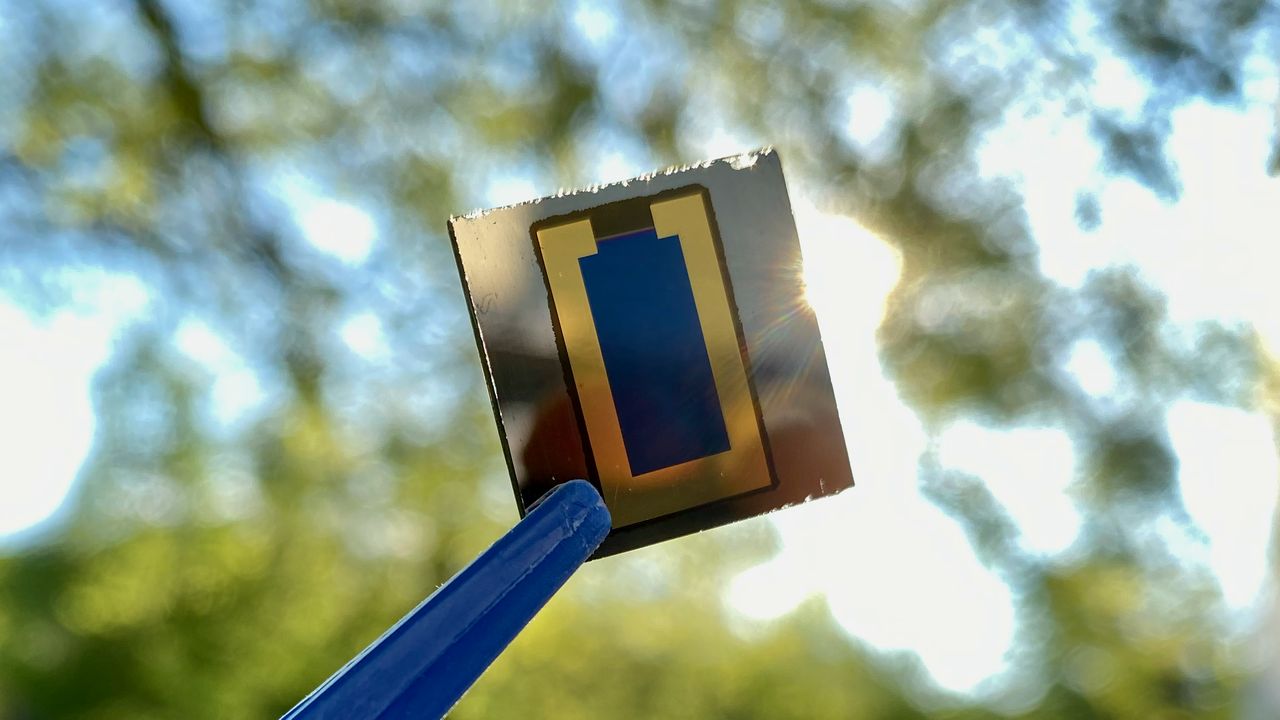Stacking solar cells increases their efficiency. Working with partners in the EU-funded PERCISTAND project, researchers at the Karlsruhe Institute of Technology (KIT) have produced perovskite/CIS tandem solar cells with an efficiency of nearly 25 percent – the highest value achieved thus far with this technology. Moreover, this combination of materials is light and versatile, making it possible to envision the use of these tandem solar cells in vehicles, portable equipment, and devices that can be folded or rolled up. The researchers present their results in the journal ACS Energy Letters (DOI: 10.1021/acsenergylett.2c00707)
Perovskite solar cells have made astounding progress over the past decade. Their efficiency is now comparable to that of the long-established silicon solar cells. Perovskites are innovative materials with a special crystal structure. Researchers worldwide are working to get perovskite photovoltaic technology ready for practical applications. The more electricity they generate per unit of surface area, the more attractive solar cells are for consumers.
The efficiency of solar cells can be increased by stacking two or more cells. If each of the stacked solar cells is especially efficient at absorbing light from a different part of the solar spectrum, inherent losses can be reduced and efficiency boosted. The efficiency is a measure of how much of the incident light is converted into electricity. Thanks to their versatility, perovskite solar cells make outstanding components for such tandems. Tandem solar cells using perovskites and silicon have reached a record efficiency level of over 29 percent, considerably higher than that of individual cells made of perovskite (25.7 percent) or silicon (26.7 percent).
Combining Perovskites with CIS for Mobility and Flexibility
Combining perovskites with other materials such as copper-indium-diselenide (CIS) or copper-indium-gallium-diselenide (CIGS) promises further benefits. Such combinations will make it possible to produce light and flexible tandem solar cells that can be installed not only on buildings but also on vehicles and portable equipment. Such solar cells could even be folded or rolled up for storage and extended when needed, for example on blinds or awnings to provide shade and generate electricity at the same time.
An international team of researchers headed by Dr. Marco A. Ruiz-Preciado and tenure-track professor Ulrich W. Paetzold from the Light Technology Institute (LTI) and the Institute of Microstructure Technology (IMT) at KIT has succeeded in producing perovskite/CIS tandem solar cells with a maximum efficiency of 24.9 percent (23.5 percent certified). “This is the highest reported efficiency for this technology and the first high efficiency level reached at all with a nearly gallium-free copper-indium diselenide solar cell in a tandem,” says Ruiz-Preciado. Reducing the amount of gallium results in a narrow band gap of approximately one electron volt (eV), which is very close to the ideal value of 0.96 eV for the lower solar cell in a tandem.
CIS Solar Cells with Narrow Band Gap – Perovskite Solar Cells with Low Bromine Content
The band gap is a material characteristic that determines the part of the solar spectrum that a solar cell can absorb to generate electricity. In a monolithic tandem solar cell, the band gaps must be such that the two cells can produce similar currents to achieve maximum efficiency. If the lower cell’s band gap changes, the upper cell’s band gap has to be adjusted to the change, and vice versa.
To adjust the band gap for efficient tandem integration, perovskites with high bromine content are usually used. However, this often leads to voltage drops and phase instability. Since the KIT researchers and their partners use CIS solar cells with a narrow band gap at the base of their tandems, they can produce their upper cells using perovskites with low bromine content, which results in cells that are more stable and efficient.
“Our study demonstrates the potential of perovskite/CIS tandem solar cells and establishes the foundation for future development to make further improvements in their efficiency,” says Paetzold. “We’ve reached this milestone thanks to the outstanding cooperation in the EU’s PERCISTAND project and, in particular, thanks to our close cooperation with the Netherlands Organisation for Applied Scientific Research.” Important groundwork was done in the CAPITANO project funded by Germany’s Federal Ministry for Economic Affairs and Climate Action (BMWK).
About PERCISTAND
In the EU-funded PERCISTAND project, researchers from academia and industry develop innovative materials and processes for tandem photovoltaics using perovskites on chalcogenides like CIS. The project’s focus is on testing four-terminal tandem solar cells and prototypes for modules on glass substrates. PERCISTAND’s aim is to improve the efficiency, stability and large-scale manufacturability of thin-film photovoltaic materials so that they can compete with the photovoltaic technologies that are already available.
About CAPITANO
In the BMWK-funded joint project CAPITANO, KIT and the Center for Solar Energy and Hydrogen Research Baden-Wuerttemberg develop innovative materials and processes for perovskite/CIGS tandem photovoltaics. The project’s results will help to further strengthen innovation in the technology cluster in Germany and the EU.
Original Publication (Open Access):
Marco A. Ruiz-Preciado, Fabrizio Gota, Paul Fassl, Ihteaz M. Hossain, Roja Singh, Felix Laufer, Fabian Schackmar, Thomas Feeney, Ahmed Farag, Isabel Allegro, Hang Hu, Saba Gharibzadeh, Bahram Abdollahi Nejand, Veronique S. Gevaerts, Marcel Simor, Pieter J. Bolt, and Ulrich W. Paetzold: Monolithic Two-Terminal Perovskite/CIS Tandem Solar Cells with Efficiency Approaching 25%. ACS Energy Letters, 2022. DOI: 10.1021/acsenergylett.2c00707
https://pubs.acs.org/doi/10.1021/acsenergylett.2c00707
Information about the EU’s PERCISTAND project: https://percistand.eu/en
More about the KIT Energy Center: https://www.energie.kit.edu
In close partnership with society, KIT develops solutions for urgent challenges – from climate change, energy transition and sustainable use of natural resources to artificial intelligence, sovereignty and an aging population. As The University in the Helmholtz Association, KIT unites scientific excellence from insight to application-driven research under one roof – and is thus in a unique position to drive this transformation. As a University of Excellence, KIT offers its more than 10,000 employees and 22,800 students outstanding opportunities to shape a sustainable and resilient future. KIT – Science for Impact.

